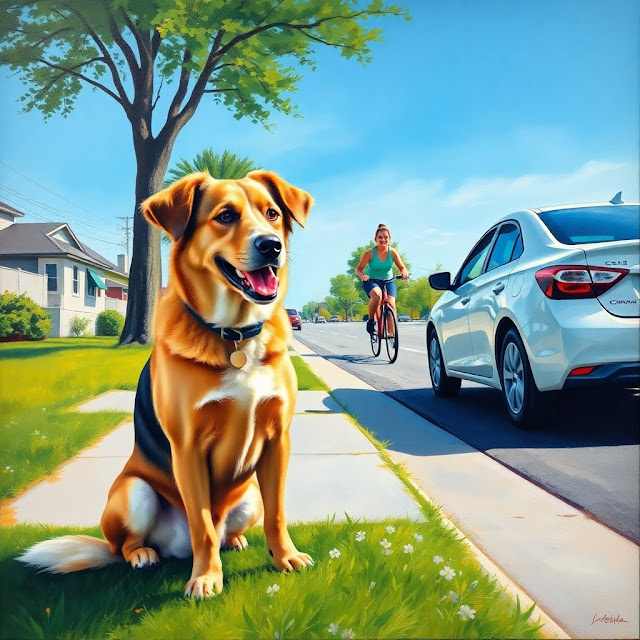Dealing with Dogs Who Chase Cars, Bicycles, or Joggers 🚗🚴🏃
Dealing with Dogs Who Chase Cars, Bicycles, or Joggers 🚗🚴🏃
Ah, the classic zoomies but make it dangerous situation—your dog suddenly takes off after a moving car, a cyclist, or a jogger, leaving you screaming their name like a horror movie protagonist. 😱 If this sounds familiar, don’t worry! You're not alone, and more importantly, you can train your dog to stop this risky behavior.
Let’s break it down step by step. 🐶💨
Why Do Dogs Chase Moving Things? 🤔
Before we fix it, let’s understand why this is happening:
1. Instincts, Baby!
Dogs have predatory instincts. Movement triggers their chase drive—it’s in their DNA. Some breeds (like Border Collies and Terriers) are more prone to it, but any dog can develop this habit.
2. Boredom & Excess Energy
A dog with too much pent-up energy will look for ways to burn it off—like chasing whatever moves. 🚗💨
3. Lack of Training
Without proper training, dogs don’t understand that chasing moving objects = danger. They just think it’s a fun game.
4. Reinforcement (Oops)
If your dog has chased something before and it was fun, they’re more likely to do it again. Even if they never caught the car (which, thankfully, they won’t), the thrill alone is rewarding.
Now that we know why, let’s tackle how to stop it. ✋
Step 1: Teach a Rock-Solid Recall Command 📣
Your first line of defense? A reliable recall (aka: teaching your dog to come back immediately when called).
How to Train Recall:
Start small – Indoors or in a fenced yard, use a happy voice and say, "Come!" 🎶
Use high-value rewards – Treats, praise, or a favorite toy. 🦴
Practice with distractions – Gradually add movement (have someone jog by, roll a ball, etc.).
NEVER punish if they don’t come – You want them to associate "Come!" with something awesome, not scary.
Reinforce daily – Repetition is key. The stronger the recall, the better your control when things get wild.
Step 2: Work on the "Leave It" Command ❌
"Leave it" is a lifesaver. It tells your dog nope, don’t even think about it when they start fixating on something.
Training "Leave It":
Hold a treat in your hand – Let them sniff but don’t let them take it.
Say "Leave it" – The second they stop trying, reward them with a different treat.
Increase difficulty – Try putting the treat on the ground, walking by it, or using a toy.
Use real-life practice – When they eye a moving object (car, bike, squirrel), say "Leave it!" and reward when they obey.

Step 3: Desensitize and Counter-Condition 🧠
Dogs need to be exposed to their triggers in a controlled way so they learn not to react.
How to Do It:
Start far away – Keep your dog on a leash and watch cars/bikes/joggers from a distance.
Reward calm behavior – The moment they look at the trigger without lunging, praise & treat!
Gradually get closer – Over time, move a little nearer while keeping them focused on you.
Practice often – Short, frequent sessions work best.
Step 4: Exercise & Mental Stimulation 🎾🧩
A tired dog is a less reactive dog!
Daily walks & playtime – Ensure your pup gets enough physical activity.
Puzzle toys & obedience training – Keep their brain busy so they’re less interested in chasing stuff.
Dog sports – Agility, fetch, or herding activities give high-energy dogs a productive outlet. ⚡
Step 5: Leash & Safety Management 🏃♂️
Until your dog is fully trained, never trust them off-leash in risky areas.
Use a secure leash & harness – Gives you better control during training.
Try a long line in safe areas – Allows them to explore while keeping them from running into danger.
Avoid high-trigger locations (for now) – Don’t set them up to fail by walking near busy roads before they’re ready.
Step 6: Emergency "Sit" or "Down" Command ⛔
Teach a fast, automatic response to stop your dog in their tracks when they fixate on something.
How to Train:
Say "Sit" or "Down" whenever they see a trigger.
Reward them for obeying, even if the trigger moves away.
Practice daily in different locations.
With enough practice, they’ll learn to stop chasing before they even start. 🤯
Step 7: Seek Professional Help If Needed 📞
Some dogs have extreme prey drive that requires expert guidance. A professional trainer or behaviorist can create a custom plan if your dog is really struggling.
Common Mistakes to Avoid ❌
Chasing after them when they run – This turns it into a game. Instead, call them cheerfully and run the other way.
Punishing them after they return – If they finally come back and you scold them, they’ll be less likely to return next time.
Letting them "just chase for fun" sometimes – Inconsistent rules = confused dog. 🚫
Final Thoughts 💡
Dealing with a dog who loves the thrill of the chase can be stressful, but with patience and training, you can fix it. The key is consistent training, proper management, and making you more interesting than the moving object. 😉
Stick with it, and soon, you’ll have a dog who walks past joggers, cyclists, and cars without a second glance. 🙌
Have any success stories (or wild chase fails)? Drop them in the comments—I’d love to hear them! 🐶👇










